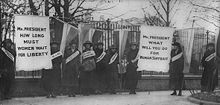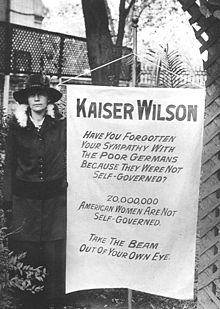National Woman's Party
The National Woman's Party ( NWP , English for National Women's Party ) was a women's political organization in the USA . The aim of the organization was to enforce women's suffrage in the USA. Although the NWP was called " party ", it did not appear as a political party and did not take part in elections.
history
The way to start
Alice Paul and Lucy Burns , two young Americans, went to England to study independently. There they joined the English women's suffrage organization Women's Social and Political Union (WSPU) led by Emmeline and Christabel Pankhurst . The two Americans got to know each other during protests and quickly became friends.
The women returned to the United States separately from England in 1910. Here they joined the National American Woman Suffragette Association (NAWSA), an American organization of suffragettes . In Washington, Paul and Burns met again. The NAWSA, led by Carrie Chapman Catt (1859–1947), did not seem assertive enough to both women who had experience as activists in radical protest for women's suffrage from England. The aim of NAWSA was to preserve the right to vote for women at the federal level through the detour via the right to vote in the individual states. Once all states had introduced women's suffrage, the American federal government could no longer ignore it. The goal should be achieved through negotiations and petitions.
Since the radical ideas of Paul and Burns did not fit into the concept of NAWSA, they founded the Congressional Union for Woman Suffrage (CUWS) within the organization in 1913 . The CUWS took care of the NAWSA's secondary goal of achieving women's suffrage at the federal level through a constitutional amendment . After several fruitless meetings with future President Woodrow Wilson , who was uninterested in their cause , Paul and Burns organized a grand parade in Washington DC on March 3, 1913 - the day before Wilson's inauguration - which ended in disaster. Under the eyes of the idle police, an angry mob attacked the parading women and injured many of them. However, this event brought the suffragettes the previously insufficient attention of the press.
In 1914 there was a rift between the NAWSA and the CUWS, the CUWS split off as an independent organization. In 1915, Paul and Burns from the CUWS founded the National Woman's Party. Both the predecessor organization and the CUWS and the NWP only accepted women as members. At the founding meeting, Paul made it clear that the NWP was not a political party and would therefore not take part in presidential elections. The relationship between the NAWSA and the NWP was tense from the beginning, the NAWSA sharply criticized the goals and actions of the NWP as too radical.
Vigils in front of the White House
The NWP began in 1916 with targeted protest actions and vigils in front of the White House , the Silent Sentinels (English for silent watch ) to draw attention to their concerns. The NWP not only protested for women's suffrage, their actions also turned against the First World War and an entry into the war by the USA. Many of the NWP's protest posters were directed against Woodrow Wilson. Quotations from speeches by "Kaiser Wilson" on the subject of human and civil rights , the NWP activists related directly to the situation of US citizens, combined with the question of when they would finally get these rights.
When the USA took part in World War I in 1917, the situation of the NWP suffragettes worsened. Their vigils in front of the White House were insulted as traitors, some were physically assaulted and arrested by the police. In October 1917, 35 women were sentenced to several months' imprisonment on flimsy grounds and imprisoned under extreme conditions in the Occoquan Workhouse women's prison (now the Lorton Correctional Complex ). The prison administration tried to break a hunger strike by the imprisoned suffragettes with systematic violence and brutal force-feeding.
The press learned about the women's detention conditions and reported extensively. This sparked violent public protest and even the previously cautious NAWSA now declared that it wanted to resort to more radical methods. Since the USA tried to distinguish itself internationally as the guardian of human and civil rights, further imprisonment of the suffragettes would have meant a significant loss of credibility for the USA. In addition, the US government could not afford a domestic political scandal in the war situation, it also needed the allegiance of women. The imprisoned NWP activists were released from custody at the end of November 1917 and the sentences were subsequently declared unconstitutional by the US Supreme Court .
On January 9, 1919, under domestic political pressure, President W. Wilson announced his support for the Constitutional Amendment. The House of Representatives passed the law with a just under two-thirds majority . However, the Senate refused to discuss the amendment, and when it voted in October 1918, two votes were missing for the required two-thirds majority. With Senate elections coming up in the fall of 1918, the NWP launched a large-scale campaign not to re-elect the senators who had voted against the constitutional amendment. The campaign was successful, with the majority of the newly elected senators in favor of women's suffrage. On May 21, 1919, the US House of Representatives passed the amendment with 340 votes to 89; two weeks later the Senate likewise with 56 to 25 votes. The 19th Amendment to the United States Constitution was ratified on August 26, 1920.
Continue for full equality
After the American women won the right to vote, many suffragettes - including Lucy Burns - withdrew from active politics. But the NWP, headed by Alice Paul, now had the aim of enshrining full equality between women and men in the US constitution . In 1921 the NWP was reorganized and in 1923 published a constitutional amendment drafted by Alice Paul, the Equal Rights Amendment (ERA).
"Equality of rights under the law shall not be denied or abridged by the United States or by any state on account of sex."
"Neither the United States nor any of its states may restrict the exercise of equal rights under the law based on gender."
In 1925, the first ERA hearings took place before Congress. At the same time, the NWP published the magazine Equal Rights , which was aimed primarily at women, but was also intended to inform men about the benefits of women's suffrage and equality.
However, it was almost fifty years before the ERA was finally approved by the Senate in 1972. Since the required number of states had not approved by the 1982 deadline, the Equal Rights Amendment was not incorporated into the constitution.
The World Woman's Party as a successor organization
At the end of the 1920s, Alice Paul expanded the activities of the NWP. During several trips abroad to South America and Europe, she founded the World Woman's Party (WWP) based in Geneva as the successor organization to the NWP, which was dissolved in 1930. The WWP later renamed itself to the World Woman's Party for Equal Rights .
With the outbreak of World War II , WWP headquarters became a refuge for a number of political refugees, but moved back to Washington in 1941 under pressure from Nazi Germany. On the initiative of WWP 1946 was the UN Commission on the Status of Women ( Commission on the Status of Women (CSW) set up) that the UN Economic and Social Council is assigned.
useful information
The story of the struggle for the 19th amendment to the Constitution was filmed in 2004 by the director Katja von Garnier under the title Iron Jawed Angels .
See also
swell
- ↑ Lakewood Public Library: Women in History ( Memento of the original from June 19, 2006 in the Internet Archive ) Info: The archive link was inserted automatically and has not yet been checked. Please check the original and archive link according to the instructions and then remove this notice.
- ↑ Equal Right Amendment: A description of the Equal Rights Amendment to the United States Constitution ( Memento of the original dated November 21, 2006 in the Internet Archive ) Info: The archive link was inserted automatically and has not yet been checked. Please check the original and archive link according to the instructions and then remove this notice.
- ↑ Lutz, Alma. Papers, 1927–1946: A Finding Aid ( Memento of the original dated September 2, 2006 in the Internet Archive ) Info: The archive link was inserted automatically and has not yet been checked. Please check the original and archive link according to the instructions and then remove this notice.
literature
- Jean H. Baker (ed.): Votes for Women. The Struggle for Suffrage Revisited (Viewpoints on American Culture). Oxford 2002: Oxford University Press.
- Amy E. Butler: Two paths to equality. Alice Paul and Ethel M. Smith in the ERA debate, 1921–1929 Albany 2002: State University of New York Press.
- Eleanor Clift: Founding Sisters and the Nineteenth Amendment. Hoboken, NJ 2003: John Wiley & Sons, Inc.
- Linda G. Ford: Iron-Jawed Angels. The Suffrage Militancy of the National Woman's Party 1912-1920. Lanham, New York, London 1991: University Press of America.
- Kristina Dumbeck: Leaders of women's suffrage. San Diego (Ca.) 2001: Lucent Books.
- Christine A. Lunardini: From equal suffrage to equal rights. Alice Paul and the National Woman's Party, 1910-1928. New York 1986: New York University Press.
- Doris Stevens: Jailed for Freedom. New York 1920: Boni & Liveright.





